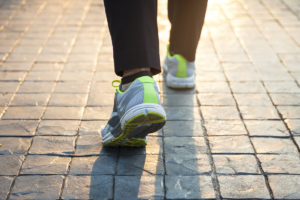Spinal Stenosis Walking Difficulties
Spinal stenosis is the narrowing of spaces inside your spinal canal and “pinches” or puts pressure on the nerves going through the canal. The two most common places for spinal stenosis to occur are the lower back and neck, which is also two major areas people experience pain. The cause of spinal stenosis is mostly wear and tear due to osteoarthritis.
Spinal stenosis is a common condition over the age of 50 and much of the time causes discomfort in the back and legs. As the stenosis progresses it puts more and more pressure on your spinal nerves it can radiate from your lower back into your legs and start really affecting how you walk, and might even make it difficult to walk. There are multiple causes for spinal stenosis however, the foremost being the wearing down of vertebrae cartilage. Your spinal vertebrae can also develop bone spurs, which then narrows the canals and compress nearby nerves. Some more conditions that cause spinal stenosis are ankylosing spondylitis, rheumatoid arthritis, a previous surgery or a spinal tumor.
Why does Spinal Stenosis cause Foot Pain?
Foot pain due to spinal stenosis happens when the collection of nerves where your spinal cord ends is pressured. The pressure interrupts messages from the end of the spinal cord to your pelvis area and legs. This causes walking issues, and if your sciatic nerve is also pinched or affected this nerve travels from your pelvis all the way down to your foot. Nerve compression comes with something called radiculopathy, which is basically a radiating pain from the original affected compressed nerve area. The foot and leg pain from sciatica can also make walking challenging.
 You may also feel numbness in the legs and feet as well as weakness, which also contributes to difficulty walking. Spinal stenosis worsens over time, so even if you don’t have trouble walking immediately and just have mild symptoms, if left untreated it might progress until the more severe symptoms show up. That’s why it’s important to consult a medical professional if you start having chronic back pain that doesn’t go away with simple over the counter medication and rest.
You may also feel numbness in the legs and feet as well as weakness, which also contributes to difficulty walking. Spinal stenosis worsens over time, so even if you don’t have trouble walking immediately and just have mild symptoms, if left untreated it might progress until the more severe symptoms show up. That’s why it’s important to consult a medical professional if you start having chronic back pain that doesn’t go away with simple over the counter medication and rest.
Symptoms you might also notice that are an indication of spinal stenosis are a pressure in your lower back when upright, pain in the back, buttocks or legs, and leg cramping, tingling or numbness. The symptoms may be relieved by leaning forward, sitting, or crouching, which relieves the pressure on your nerves.
Can Physical Therapy Help Spinal Stenosis?
Exercise and physical therapy are important in the process of recovery when experiencing spinal stenosis. Your doctor might recommend working with a professional physical therapist or give you a recommended routine based on the severity of your symptoms. If walking is difficult because of the spinal stenosis you can try water based aerobics or swimming. The goal of physical therapy is to strengthen the back muscles and connective tissues, develop your core muscles to support your spine, and reduce inflammation due to increased circulation.
Generally physical therapy is the first treatment option when it comes to spinal stenosis, and is an effective way to stave off lower back pains. Coupled with conservative measures like pain medications, anti-inflammatory medicine and possibly epidural injections, exercise is an effective way to treat spinal stenosis. If symptoms don’t improve, however, surgery may be looked at as the next valid option in treating debilitating spinal stenosis. If you’re trying an exercise routine first, there are a few exercises you might want to avoid during the start of the recovery process.
Spinal Stenosis Exercises to Avoid
Bending over backwards will probably worsen your symptoms and pain. It’s a pretty common sight to see, a person standing up after sitting down for a long time with their hands on their hips and leaning backwards to stretch. Though the increased compression on the aggravated area can make the inflammation worse. Avoiding excessive extension of your back is the recommended route when it comes to spinal injuries.
 Running and jogging is a typical go to exercise for many people. If you have a back injury though it can put undue stress and pressure on your spine. The impact is emphasized if you only have a hard surface to run on like pavement, and don’t have a soft trail to run on. Start out with short walks and slowly increase the pace or distance of the walk over time during recovery. Walking for too long of a distance can have a similar effect as running on a hard surface, so the key here is to gradually work your way up.
Running and jogging is a typical go to exercise for many people. If you have a back injury though it can put undue stress and pressure on your spine. The impact is emphasized if you only have a hard surface to run on like pavement, and don’t have a soft trail to run on. Start out with short walks and slowly increase the pace or distance of the walk over time during recovery. Walking for too long of a distance can have a similar effect as running on a hard surface, so the key here is to gradually work your way up.
You’ll also want to avoid any and all contact sports. Football, basketball, and martial arts are a few that can possibly exacerbate a spine injury since the sudden impact on your body can cause further compression of a spinal nerve. Working with an expert PT is the best way to go to ensure you’re on track while you heal and don’t cause any further damage or setbacks.


